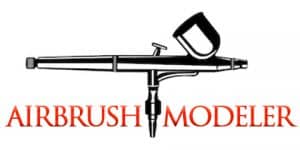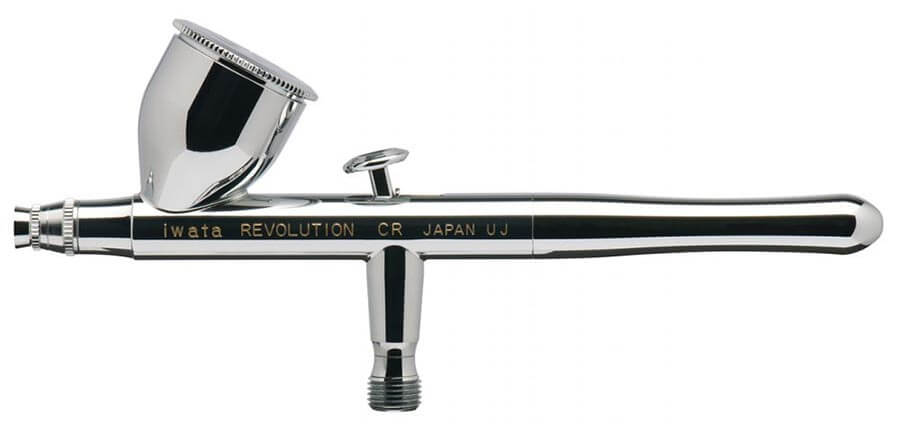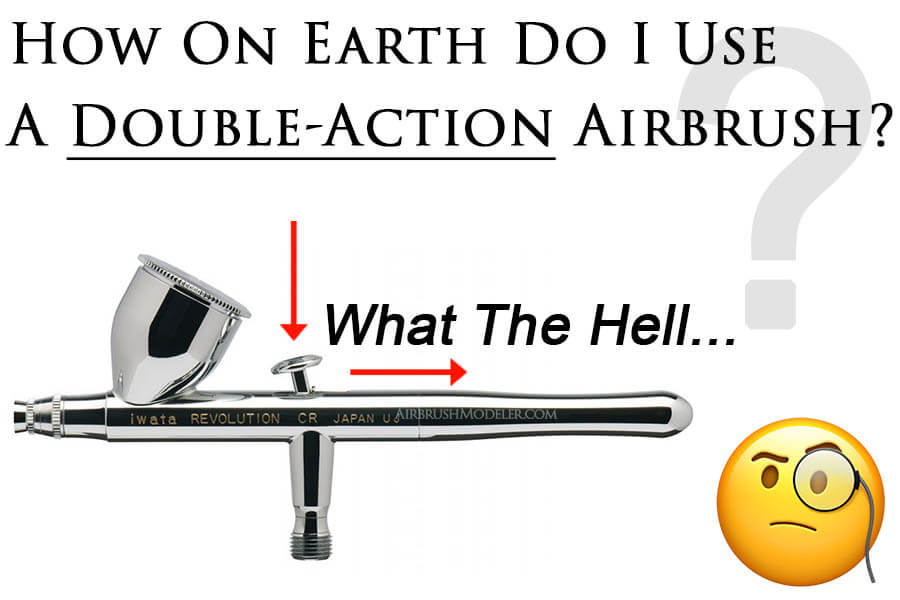What Are The Different Types Of Airbrush
There are three main categories that dictate the type of airbrush, with multiple variations in each category, those categories being; the feed type, the mix type, and the trigger-action type.
The three categories that define an airbrush type:
- Feed Type: the feed type refers to where the paint is fed from to get into the airbrush airflow, with the feed types being siphon feed (paint cup below the airbrush), side feed, and gravity feed (paint cup above the airbrush);
- Mix Type: mix type relates to where the paint mixes with the high pressure air so that it can be atomised, and is classified as internal mix or external mix;
- Trigger-Action Type: the trigger action refers to whether the trigger moves in only one plane of motion to get paint flow (single-action airbrush), or two planes of motion to regulate airflow and well as paint flow (dual or double action airbrush);
An airbrush type will be defined and named using all three categories, an example being:
…a siphon-feed, single-action, external-mix airbrush.
Take a look at all of the variations below so that you’re fully up to speed with the different airbrush types and can narrow down which one is best for you personally…
What Is A Siphon Feed Airbrush
A siphon feed airbrush has the paint holder or cup hanging below the airbrush body, with a paint tube leading from the paint in the paint holder to a point in the high pressure airflow, so that the compressed air can siphon the paint out of the cup to be sprayed.
As the high pressure air passes over the end of the paint tube is sucks the paint up and into the airflow where it is atomised into extremely fine droplets and then sprayed onto the job.
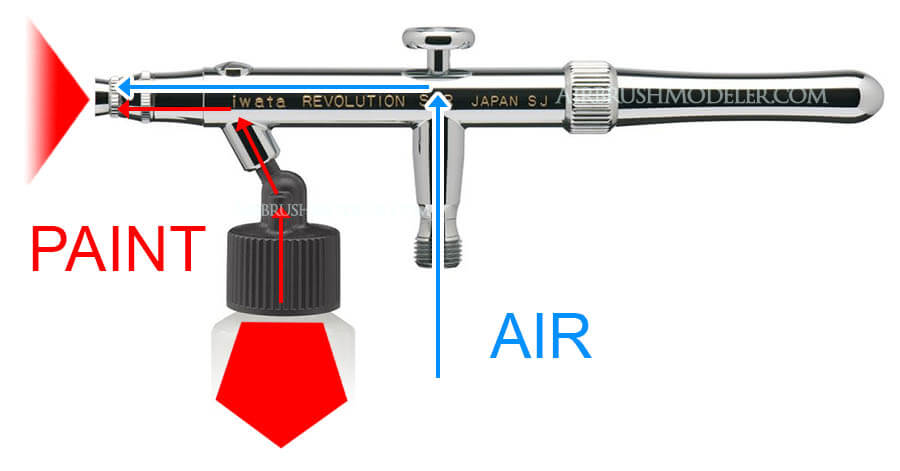
The siphon feed airbrush is very common and is usually considered a beginners or intermediate airbrush, however in the hands of a skilled airbrush user outstanding paintwork quality can be achieved.
The paint bottles are quickly interchangeable and come in a variety of sizes from small to quite large, and are usually very easy to clean.
👍 To learn the pros and cons of a siphon feed airbrush relative to a gravity feed, and which one is better, check out this detailed article.
What Is A Gravity Feed Airbrush
A gravity feed airbrush is one that has the paint cup on top of the airbrush which allows the paint to be drawn down into the body of the airbrush by gravity, where it then mixes with the high pressure air to be atomised and sprayed onto your work.
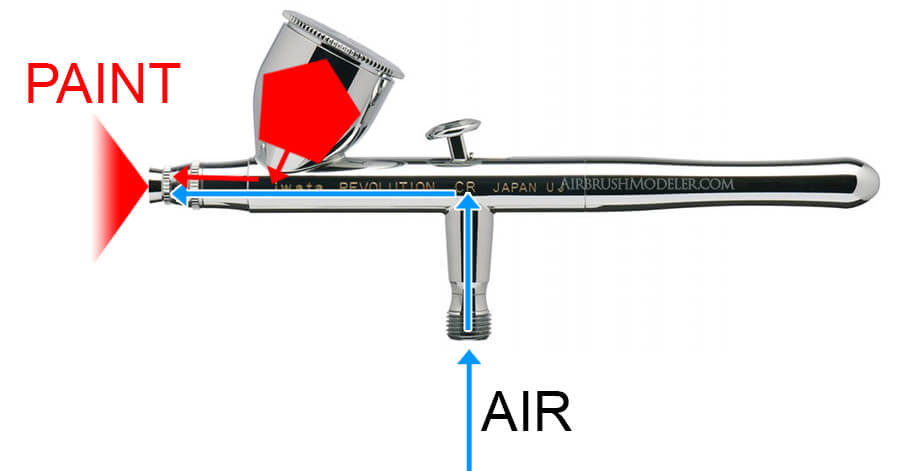
A gravity feed airbrush does require a source of compressed air in the same fashion as any other airbrush does, a point sometimes confused by people new to airbrushing who mistakenly think that gravity does the work of the compressed air.
These airbrushes are also often considered a more professional style of airbrush owing to the perfect spray pattern they can achieve at lower average air pressures, which allows for much finer detail work to be achieved by the artist or modeler.
While gravity feed airbrushes do come in different paint cup sizes they’re typically much smaller than their siphon feed counterparts and will require refilling more often on larger paint jobs.
👍 For in-depth details on how a gravity feed airbrush works check out this article.
What Is A Side Feed Airbrush
A side feed airbrush is one which has the paint cup located directly to the side of the airbrush body and depending on its orientation and use the airbrush could be considered both siphon feed and gravity feed.
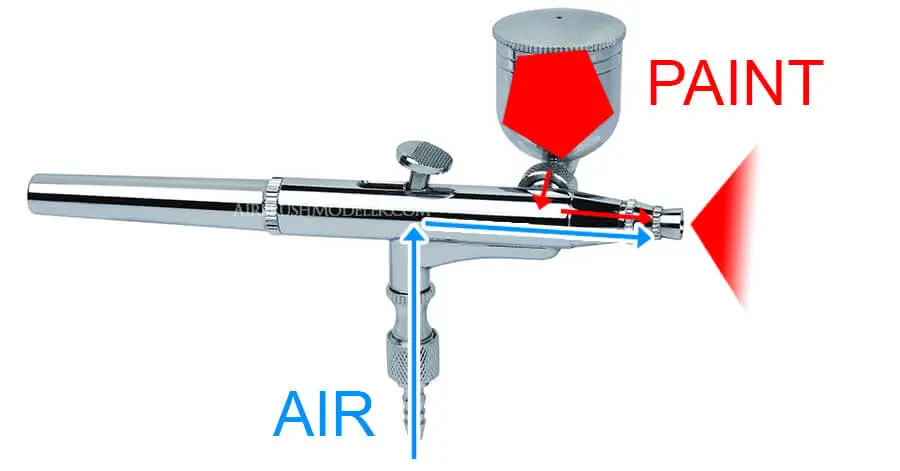
Technically, if the top level of the paint in the paint cup is above the airbrush nozzle where the atomised paint spray out, then the side feed airbrush acts as a gravity feed airbrush.
Conversely, if the top level of the paint in the paint cup is below the airbrush nozzle, then the airbrush acts as a siphon feed.
Side feed airbrush are not overly common and you will see fewer option available than compared to siphon feed and gravity feed airbrush types.
This, however, certainly doesn’t mean that they’re any less capable.
👍 or a full detailed article on the pro’s and cons of side feed airbrushes and whether it’s the right choice for you, check out this link.
What Is An Internal Mix Airbrush
An internal mix airbrush is one that mixes the paint with the airflow inside the airbrush body, in an area of the airbrush called the atomisation chamber.
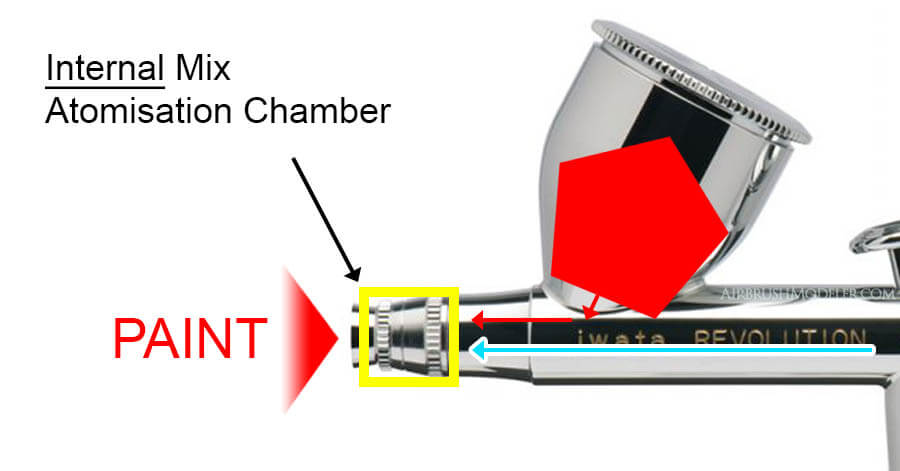
All gravity feed and side feed airbrushes are internal mix as it isn’t practical to engineer them to be external mix.
What Is An External Mix Airbrush
And external mix airbrush is one which introduces the paint into the compressed air flow outside of the airbrush body, with this mixing area being simply called the atomisation area.
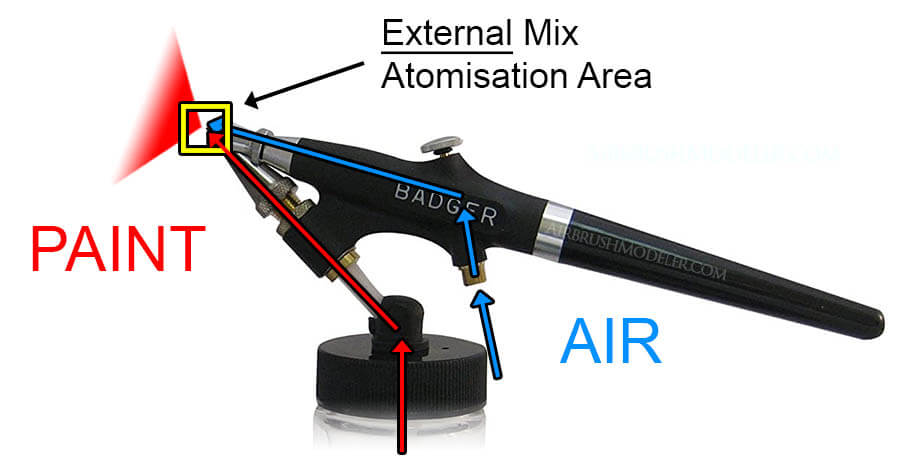
Only siphon feed type airbrushes will be external mix, as it’s not over practical for the gravity or side feed type airbrushes to function with an external mix system.
The high pressure air passing through and out of the airbrush essentially sucks the paint out of the paint tube leading down into the paint jar beneath the airbrush.
What Is A Single Action Airbrush
A single action airbrush is named this because of the single movement capability of the trigger, meaning it can only be pressed down to provide a fixed amount of paint and will not move in any other direction.
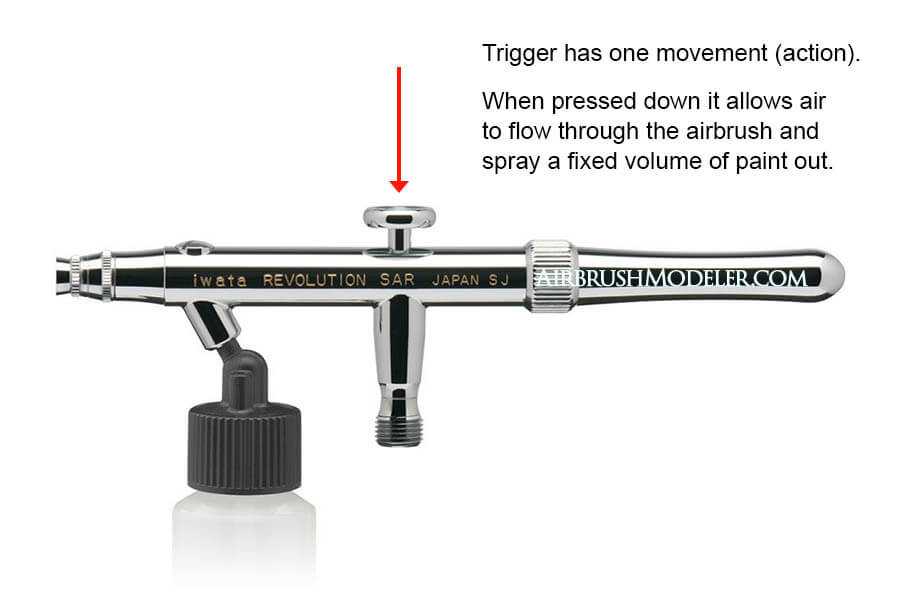
The amount of paint that sprays on a single action airbrush can be controlled, however rather than using the trigger mechanism, the amount of paint flow is set by turning a part of the airbrush that adjusts the nozzle opening size.
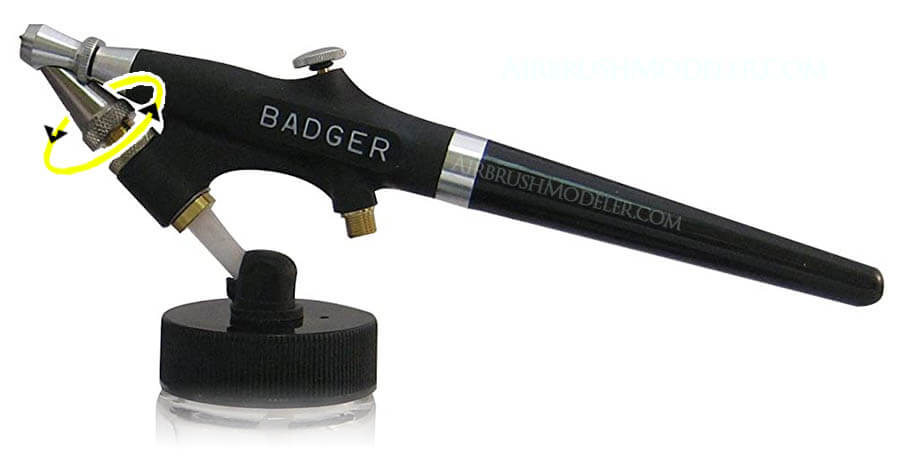
👍 For in-depth details on how a single action airbrush is different from a double action airbrush check out this article.
Single action airbrushes are more simple to use and are more a beginner type airbrush, however they will still give excellent results generally, only falling short where more paint-flow-control is needed for technical artwork and painting.
What Is A Dual Action or Double Action Airbrush
A double action airbrush is one that has a trigger which moves in two distinct ways, where pressing down allows high pressure air to flow through the airbrush, and pulling the trigger back allows increasingly more paint the spray.
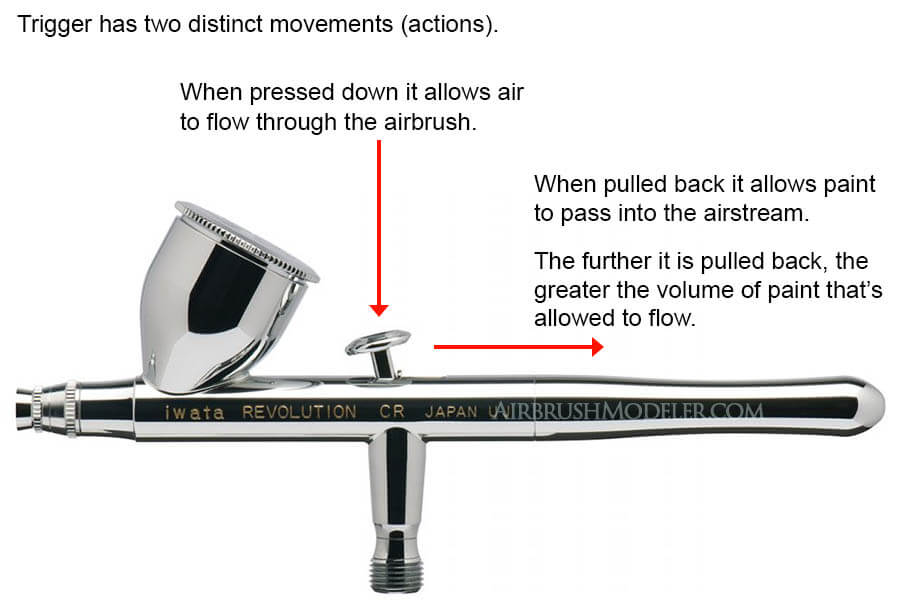
If the trigger is pulled back a small amount, a small amount of paint will be atomised and airbrushed onto your job.
Conversely, if the trigger is pulled back a long way a lot more paint will be allowed to spray.
In this way the airbrush user is given a huge amount of control by adjusting the amount of paint being sprayed on the fly, and providing much greater opportunity to complete more advanced painting, detail work and creative effects.
👍 For in-depth instructions on how to use a double action airbrush including pictures and downloads, check out this detailed article.
What Type Of Airbrush Is The Best
The type of airbrush that is best for you depends on what level of competency you are with regards to airbrushing.
Beginner Airbrush Users
Most beginners would benefit from an airbrush that has a shallower learning curve and this would be characterised by a:
…siphon feed, external mix, single action airbrush
The siphon feed and external mix components will prove somewhat easier to clean and the overall operating mechanism may be easier to understand overall.
Some examples of siphon feed, external mix, single action airbrushes are below…
Single Action Airbrush Model | Reviews & Current Prices | |
Paasche Airbrush H-Set Single Action Siphon Feed External Mix Airbrush Set | ||
Badger 350 Single Action Siphon Feed External Mix Airbrush Set | ||
Advanced Airbrush Users
For the more advanced airbrush user, or for those who want to have a very capable airbrush that they can grow into as their skills improve, and internal-mix double-action airbrush is likely the best option.
All three feed types, siphon, side and gravity feed, come with internal mix options.
All three feed types also come with double action trigger type options as well, and this is hugely beneficial as your skills improve as the ability to alter the volume of paint being sprayed at any given time will allow for much better paint control and paintwork results.
Some excellent examples of all three feed types that are internal mix and double action trigger type are shown below…
Single Action Airbrush Model | Reviews & Current Prices | |
Iwata Revolution HP-BCR Double-Action Siphon-Feed Internal-Mix Airbrush | ||
Badger 100 Double-Action Side-Feed Internal-Mix Airbrush | ||
Iwata Revolution HP-CR Double-Action Gravity-Feed Internal-Mix Airbrush | ||
With regards to the more complex double action airbrushes, the beginner should not be scared away from them.
👍 Yes, the learning curve is steeper, however you can get up to speed very quickly especially if you follow some basic tutorials and instructions such as the ones in this detailed right here on this website.
What Is A Good Airbrush For Modeling
A good airbrush for modeling, generally speaking, is one that allows the user flexibility to paint larger areas including heavy wet coats, as well as small parts that don’t require huge amounts of paint, as well as being able to sometimes change the amount of paint being sprayed on the fly.
Ultimately this means that the best airbrush type for modeling is a gravity-feed, double-action internal-mix airbrush, and here’s why…
Airbrush Categories And The Best Airbrush For Modeling
Feed Type: The feed type, being siphon, side or gravity feed, will not materially impact the flexibility of the airbrush in terms of paint volume delivery and no one feed type is better than another.
Trigger Type: A double action airbrush, where the volume of paint being sprayed is easy to manipulate, provides excellent flexibility for painting large areas and small parts. A double action airbrush will always be internal mix.
Mix Type: Internal mix will be required in order to get a double action trigger mechanism.
Additional Airbrush Options For Modelers
As discussed earlier, to alter the amount of paint being sprayed on the fly a double action airbrush is required.
Where a double action (and therefore internal mix) airbrush is used, such an airbrush will always have a needle as part of the componentry used to atomise the paint properly.
The benefit here is that a specific needle size can be chosen that is a good middle ground for giving enough paint to cover large areas well, but is also capable of delivering small amounts of paint to cover tiny model parts.
Typically speaking such a needle size (and associated nozzle size) would be between 0.35 and 0.5mm.
👍 For more in-depth information on needle sizes and what the different sizes of needles are capable of check out this detailed article.
So when all things are considered, the best type of airbrush for modeling is a gravity feed, double action internal mix airbrush.
This does not mean a siphon feed airbrush or an external mix airbrush aren’t good airbrushes as well, but if you’re looking for the most versatile airbrush possible for building and painting models then a gravity feed, double action internal mix airbrush is the one to go for. 👍
